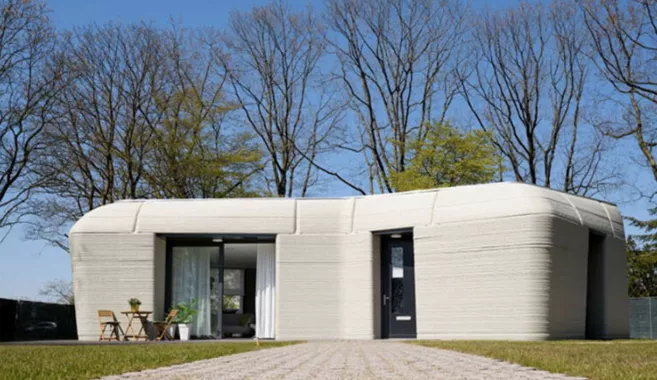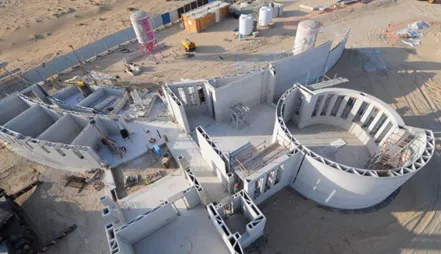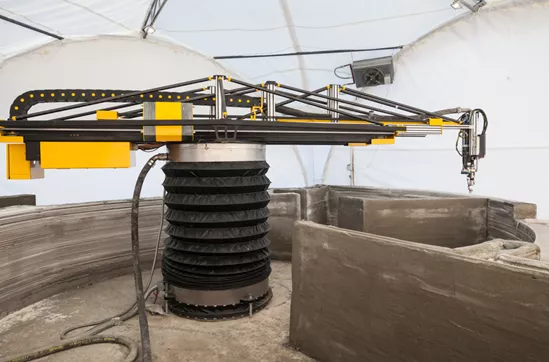Imagine a city where buildings sprout from the ground into the sky in a matter of days, not months or years. Where each structure is unique, designed not only for aesthetic amazement but also for unprecedented efficiency. This vision, which once belonged to the realm of science fiction, is being transformed into reality thanks to 3D printing in construction. In places from Amsterdam to Shanghai, 3D printers are creating everything from pedestrian bridges to multi-story houses, redefining the art of building and promising a new era of architectural innovation.
3D printing, or additive manufacturing, began in the 1980s as a tool for rapid prototyping in engineering and product design. However, its potential was not long limited to small objects and models. As the technology advanced, so did its scale and applicability. At the beginning of the 21st century, construction pioneers began experimenting with 3D printers capable of exuding concrete, plastic, and other materials, dreaming of a future where structures were built layer by layer with digital precision and unparalleled customization. Today, that vision is taking shape in projects around the world, ushering in a revolution in the way we conceive and build our environment.
3D printing is revolutionizing construction, not as a mere novelty, but as a powerful force of change that offers new possibilities and challenges. With the promise of increasing efficiency, reducing waste, and democratizing design, this technology is redefining the boundaries of architecture and engineering. However, along with its transformative potential, 3D printing also raises significant questions about sustainability, regulation, and the future of work in the construction industry. This article dives into the world of 3D printing in construction, exploring how it is changing the construction landscape and what it means for the future of our cities.
What is 3D printing in construction?
3D printing in construction, also known as additive construction, is the process of manufacturing three-dimensional components of buildings and structures layer by layer using a large-scale 3D printer. Unlike traditional construction methods, which are predominantly subtractive (cutting or sculpting material from a larger block), 3D printing adds material only where it is needed, following a detailed digital design. This approach allows for unprecedented flexibility and customization in construction, allowing for shapes and structures that would be difficult, expensive, or even impossible to achieve with conventional techniques.
In practice, a construction 3D printer is typically a large machine that moves along multiple axes to deposit construction material. Designs are first created in 3D modeling software, then fed to the printer, which runs them in the real world, extracting the material layer by layer, from the foundation to the final structure.
Technologies and materials: 3D printing technologies in construction vary, but the most common include material extrusion, where the material is pressed through a nozzle, and layer solidification, where a binding agent is used to solidify a powder material. Some of the most advanced techniques even use lasers or adhesives to fuse powdered materials into precise shapes.
The materials used in construction 3D printing are also diverse and constantly evolving. Concrete is the most common, especially formulations designed to flow easily through the printer nozzle and then harden quickly. Other materials include plastics, resins, metals, and even special compounds mixed with additives to improve strength, durability, or thermal insulation. Some researchers and companies are even exploring the use of sustainable materials such as soil or biomaterials for 3D printing, which could further reduce the environmental impact of construction.
In summary, the 3d print in the construction represents a fusion of software, hardware and materials science, each aspect contributing to the ability to create structures in innovative ways, with improved efficiency and often with a reduction in cost and waste compared to traditional methods. As technology advances, we are likely to see greater diversity in the techniques and materials used, opening up even more possibilities for what can be built.
Advantages of 3D printing in construction
Efficiency and speed
3D printing is revolutionizing construction by significantly increasing efficiency and reducing construction times. Traditionally, building a structure involves multiple stages and labor, each with its own set of delays and potential errors. 3D printing simplifies this process by automating much of the construction.
3D printers can work day and night without interruption, speeding up the construction process from weeks or months to days. For example, a small house or building component can be printed in just 24 hours, an achievement unthinkable with conventional methods. Additionally, the digital precision of 3D printing means that each item is produced exactly to specifications, reducing time and resources spent on corrections and adjustments.
Cost and waste reduction
One of the most significant benefits of 3D printing in construction is its ability to reduce material waste and therefore costs. In traditional methods, it is estimated that up to 30% of the material can be wasted. 3D printing, being an additive process, uses only the material necessary to create the structure, minimizing excess. This not only reduces the cost of materials but also contributes to sustainability by decreasing the amount of waste generated. Additionally, by reducing the need for labor and construction time, labor and overhead costs also decrease, making construction more economical overall.
Customization and complexity
3D printing opens up a world of possibilities in terms of customization and architectural complexity. With 3D printing, architects and engineers are not limited by the restrictions of traditional construction methods. They can design and build curved, intricate, custom shapes that would be extremely difficult or expensive to make otherwise.
For example, 3D printing has enabled the construction of complex facades, optimized structural components, and unique decorative elements that reflect the designer’s vision without the constraints of prohibitive costs. This design freedom not only allows for richer architectural expression but can also contribute to the functionality of buildings, such as optimizing daylight or improving thermal efficiency.
Case studies and current innovations
3D printing in construction is marking a before and after in the industry, with pioneering projects and recent innovations that are redefining what is possible. Below are notable examples and exciting developments in this field.
Pioneer projects
- The 3D printed house in Eindhoven, Netherlands: At the Technical University of Eindhoven, one of the first 3D printed habitable houses has been built. This house, part of a project called “Project Milestone“, is not only structurally sound but also features a unique and complex design that demonstrates the flexibility of 3D printing1.

- The 3D printed concrete bridge in Madrid, Spain: This 3D printed pedestrian bridge, located in the Castilla-La Mancha park, is an example of how 3D printing can be used to create public infrastructure. Its intricate design and construction efficiency represent a significant advance in civil engineering.
- 3D printed buildings in Dubai, United Arab Emirates: Dubai has set a goal for 25% of its new buildings to be built with 3D printing by 2030. They have already started several projects, including offices and other public buildings, setting a standard for the future of urban construction2.

Recent innovations
- Advanced materials: Innovations in materials are expanding the possibilities of 3D printing in construction. For example, lighter, stronger, and more sustainable concretes and composites are being developed, which can be 3D printed and offer improved properties compared to traditional materials.
- 3D printing and sustainability: Techniques are being explored to make 3D printing more sustainable, such as using recycled or local materials for printing. Additionally, the ability to print structures optimized for resource-efficient use is contributing to greener construction.
- Automation and scale: The integration of 3D printing with automated and robotic systems is enabling construction on a larger scale and with greater precision. This not only increases efficiency, but also reduces risks and improves safety on construction sites.
- 3D printing in challenging environments: Projects are underway to use 3D printing in extreme environments, such as in space or in remote regions of Earth. For example, NASA is investigating how 3D printing could be used to build habitats on Mars using local materials.
Challenges and considerations
- Technical and logistical: Addresses technical challenges, such as scale and strength of materials.
- Regulations and Safety: Discusses legal and safety considerations in 3D printing habitable structures.
- Impact on employment and the industry: Reflect on how 3D printing is changing the employment landscape and the construction industry.
The future of 3D printing in construction
3D printing in construction is not just a fad; It is laying the foundation for a radical change in the way we conceptualize, design, and build our environment. As we look to the future, several emerging trends and potential long-term trends are shaping up to shape this revolution.
Emerging trends
- Integration with artificial intelligence and generative design: The combination of 3D printing with AI and generative design allows the creation of structures and shapes that were previously impossible. These technologies can optimize design to improve material efficiency, durability and aesthetics, taking customization and innovation to new levels.
- Advanced and sustainable materials: Continuous research in materials not only seeks to improve strength and durability but also incorporates capabilities such as self-healing, adaptability to the environment, and sustainability. Recycled and local materials are gaining attention, reducing carbon footprint and costs.
- Construction in extreme environments: 3D printing has the potential to build in places previously inaccessible or too dangerous for traditional methods. From disaster zones to outer space, 3D printing could be the key to building in the most challenging environments.
- Full Automation: The vision of fully automated construction, where 3D printers work alongside drones and robots to build, inspect, and repair structures, is getting closer. This automation would not only increase efficiency but also improve safety on construction sites.
Long term potential
- Transforming the construction industry: In the long term, 3D printing has the potential to democratize construction, making it faster, less expensive, and accessible. It could lead to an era of mass custom design, where each building or structure can be unique without incurring prohibitive costs.
- Impact on urban design and housing: With the ability to build quickly and at low cost, 3D printing could play a crucial role in addressing the global housing crisis, providing high-quality, affordable shelter. Furthermore, flexibility in design could encourage a new approach in urban design, focused on sustainability, efficiency, and aesthetics.
- Promoting sustainability: 3D printing promises more sustainable constructions, with less waste and more efficient use of resources. In the long term, this could contribute significantly to reducing the carbon footprint of the construction industry, one of the largest in the world.
- Change in workforce and education: As 3D printing becomes widespread, the workforce will need to adapt, acquiring new skills and roles. This will drive changes in education and training, preparing the next generation of builders, designers, and engineers for a world of digitalized construction.
Conclusions
This is an exciting time in the field of construction and architecture. 3D printing is on the cusp of transforming not only how we build, but also how we live, work, and interact with our environment.
3D printing in construction is not only a promise of a more efficient and sustainable future; It is a window to a world of unlimited possibilities. As we move forward, let us carry with us the curiosity, boldness, and vision to build not only buildings, but communities, cities and lives that reflect the best of what we can imagine and achieve together.
In closing, I would like to share a reflection that captures the spirit of this transformative technology:
“3D printing is not just a new way of building; it is an invitation to imagine a world where each structure is as unique as the people who inhabit it, where efficiency and creativity go hand in hand, and where the limits of what that we can create expand with each layer we add.
References
- Chris Price; “Dutch couple become first to move into 3D printed house”; Daily Tech Digest: May 1, 2021; https://www.techdigest.tv/2021/05/tech-digest-daily-round-up-dutch-couple-become-first-to-move-into-3d-printed-house.html
- https://www.arch2o.com/25-dubai-buildings-will-3d-printed-2030/

